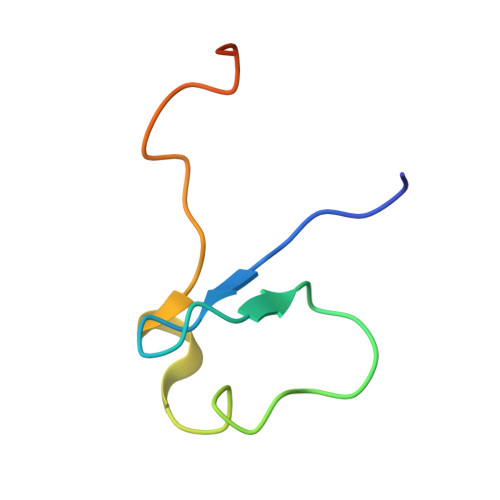Structural basis for recognition of AT-rich DNA by unrelated xenogeneic silencing proteins
Gordon, B.R.G., Li, Y., Cote, A., Weirauch, M.T., Ding, P., Hughes, T.R., Navarre, W.W., Xia, B., Liu, J.(2011) Proc Natl Acad Sci U S A 108: 10690-10695
- PubMed: 21673140
- DOI: https://doi.org/10.1073/pnas.1102544108
- Primary Citation of Related Structures:
2L92, 2L93 - PubMed Abstract:
H-NS and Lsr2 are nucleoid-associated proteins from Gram-negative bacteria and Mycobacteria, respectively, that play an important role in the silencing of horizontally acquired foreign DNA that is more AT-rich than the resident genome. Despite the fact that Lsr2 and H-NS proteins are dissimilar in sequence and structure, they serve apparently similar functions and can functionally complement one another. The mechanism by which these xenogeneic silencers selectively target AT-rich DNA has been enigmatic. We performed high-resolution protein binding microarray analysis to simultaneously assess the binding preference of H-NS and Lsr2 for all possible 8-base sequences. Concurrently, we performed a detailed structure-function relationship analysis of their C-terminal DNA binding domains by NMR. Unexpectedly, we found that H-NS and Lsr2 use a common DNA binding mechanism where a short loop containing a "Q/RGR" motif selectively interacts with the DNA minor groove, where the highest affinity is for AT-rich sequences that lack A-tracts. Mutations of the Q/RGR motif abolished DNA binding activity. Netropsin, a DNA minor groove-binding molecule effectively outcompeted H-NS and Lsr2 for binding to AT-rich sequences. These results provide a unified molecular mechanism to explain findings related to xenogeneic silencing proteins, including their lack of apparent sequence specificity but preference for AT-rich sequences. Our findings also suggest that structural information contained within the DNA minor groove is deciphered by xenogeneic silencing proteins to distinguish genetic material that is self from nonself.
Organizational Affiliation:
Department of Molecular Genetics, University of Toronto, Toronto, ON, Canada M5S 1A8.


















